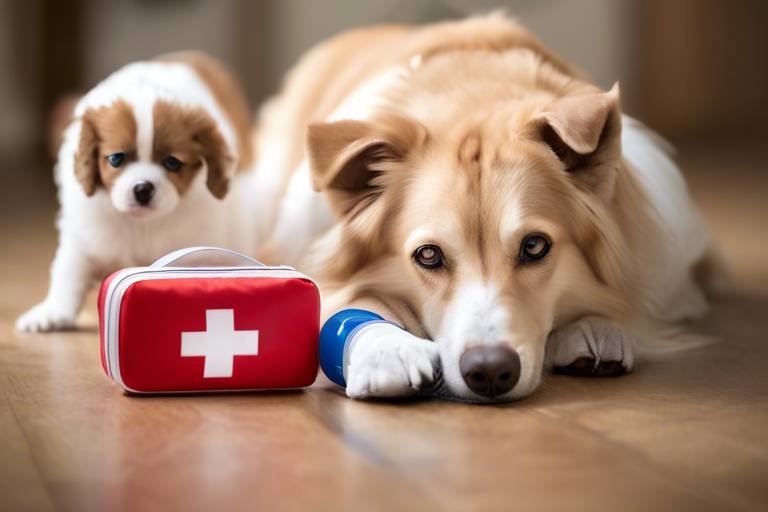Essential Safety Tips for Traveling with Pets
Traveling with your furry friends can be one of the most rewarding experiences, but it also comes with its own set of challenges. Whether you're heading to the beach, the mountains, or just a weekend getaway, ensuring your pet's safety and comfort is paramount. Imagine the joy of exploring new places together, but also consider the potential pitfalls if you're not prepared. This article provides essential safety tips for pet owners traveling with their furry companions. It covers preparation, transportation, and care to ensure a smooth journey for both pets and their owners.
Preparation is key when traveling with pets. Just like you wouldn’t head out on a road trip without checking your car, you shouldn’t embark on a journey with your pet without proper planning. First and foremost, ensure your pet is up-to-date on vaccinations. Many hotels and travel destinations require proof of vaccinations, so having these documents handy will save you from potential headaches. Additionally, consider packing a travel kit for your pet, which should include:
- Food and water bowls
- Enough food for the duration of the trip
- Leash and harness
- Favorite toys and blankets for comfort
- Any medications your pet may need
Also, take some time to acclimate your pet to their travel environment. If they’re not used to being in a car or a crate, start with short trips to help them adjust. It’s all about making the journey as stress-free as possible for both of you!
Selecting suitable transportation is crucial for your pet's safety. Different modes of travel come with different challenges, and understanding these can make all the difference. For instance, traveling by car can be a breeze if you follow a few simple guidelines, while air travel requires a bit more preparation. Let's dive into each option!
Car travel can be enjoyable for pets if planned correctly. Imagine your dog’s tail wagging as they feel the wind in their fur! However, safety should always come first. Make sure your pet is secured properly in the vehicle. This can be done using a pet seat belt or a secure carrier. Not only does this minimize distractions for the driver, but it also protects your pet in the event of sudden stops or accidents.
Properly securing your pet in the vehicle is vital. Using pet seat belts or carriers designed for travel can help keep your furry friend safe and comfortable. Remember, a loose pet can be a dangerous distraction while driving. Think of it like securing a child in a car seat; it’s all about safety!
Car sickness can be a common issue for pets, and it can turn a fun trip into a nightmare. To alleviate nausea, consider the following strategies:
- Feed your pet a light meal a few hours before the trip.
- Take regular breaks to let them stretch their legs and relieve themselves.
- Consult your veterinarian about possible medications to help with motion sickness.
By taking these steps, you can help your pet enjoy the ride as much as you do!
Air travel poses unique challenges for pets, but with the right preparation, it can be a smooth experience. First, research and choose pet-friendly airlines that understand the needs of traveling pets. Each airline has its own requirements for pet carriers, so be sure to check these before you book your tickets. Additionally, acclimatizing your pet to their carrier before the flight can help ease anxiety. Think of it as a little adventure for them!
Finding suitable accommodations is essential for a comfortable stay. After all, you want to relax after a long day of travel! Researching pet-friendly hotels can enhance your travel experience significantly. Look for places that offer pet amenities, such as dog parks or walking trails. This way, your pet can stretch their legs and enjoy the surroundings just like you!
When booking your stay, check online reviews and ratings to ensure the hotel is truly pet-friendly. Some hotels charge extra fees for pets, while others may have weight restrictions. Make sure to clarify these details when making your reservation. A little research can prevent any surprises upon arrival!
Many destinations offer pet-friendly activities, and exploring these areas can be a delightful experience. From parks to pet-friendly beaches, there are plenty of places where your pet can enjoy some fun in the sun. Don’t forget to check local regulations and leash laws to ensure a smooth outing.
Q: What should I do if my pet gets anxious while traveling?
A: Consider using calming products like pheromone sprays or consult your vet for medication options to help ease their anxiety.
Q: Are there specific airlines that are better for pet travel?
A: Yes, some airlines are more pet-friendly than others. Research airlines that have good reputations for pet travel and check their specific policies.
Q: Can I take my pet to restaurants or cafes?
A: It depends on local laws and the establishment’s pet policy. Always check ahead to avoid any issues.

Preparing for the Trip
When it comes to traveling with your furry friends, preparation is absolutely key. Just like you wouldn’t head out on a long road trip without packing your essentials, your pet deserves the same level of consideration. Before you even think about hitting the road or boarding a plane, there are several important steps you should take to ensure a smooth journey for both you and your pet.
First and foremost, vaccinations are critical. Make sure your pet is up-to-date on their shots. Some destinations may require specific vaccinations, so check the regulations for your travel location. This not only protects your pet but also ensures that they can enjoy their trip without any health concerns. You might also want to consider getting a health certificate from your veterinarian, especially if you’re traveling across state lines or internationally.
Next, let’s talk about packing supplies. Just as you would prepare your own suitcase, you need to create a travel kit for your pet. This kit should include:
- Food and water bowls
- Enough food for the entire trip, plus a little extra
- Leashes, harnesses, and any necessary training tools
- Comfort items like their favorite blanket or toy
- Medications and a first-aid kit
By having these essentials on hand, you can help your pet feel more at home, no matter where you are. Another tip? If your pet has any special needs or routines, try to maintain them as closely as possible during your travels. This could mean sticking to their usual feeding schedule or making sure they have time to play and relax.
Additionally, it’s crucial to ensure your pet is comfortable and ready for the journey ahead. Take some time to acclimate your pet to their travel carrier or crate before the trip. Allow them to explore it at home, turning it into a cozy space filled with their favorite toys and treats. This will help reduce anxiety when it’s time to travel.
Lastly, don’t forget to plan for breaks if you’re driving. Just like you need to stretch your legs, your pet will appreciate the chance to get out, relieve themselves, and explore new surroundings. Aim for a break every couple of hours, and always keep a leash handy to ensure their safety during these stops.
In conclusion, preparing for a trip with your pet involves more than just packing a bag. It’s about making sure they are healthy, comfortable, and ready to enjoy the adventure alongside you. With a little planning and foresight, you can create a memorable journey that both you and your pet will cherish!

Choosing the Right Transportation
When it comes to traveling with your furry friends, choosing the right transportation is absolutely crucial for their safety and comfort. After all, a smooth journey starts with making the right choices! Whether you’re hitting the open road or soaring through the skies, understanding your options can make all the difference. Have you ever thought about how your pet feels during travel? Just like us, they can experience anxiety, discomfort, and even fear. So, let’s dive into the various transportation methods and discover the best ways to keep your pet happy and safe.
First up, let’s talk about car travel. Many pet owners prefer this option because it allows for flexibility and control. You can stop whenever you need, and your pet can enjoy the sights and smells along the way. However, it’s essential to ensure that your vehicle is pet-proofed. This means securing any loose items that could become dangerous projectiles during sudden stops and making sure your pet is safely secured in the back seat. Think of it like buckling up yourself; your pet deserves the same level of protection!
Now, if you’re considering flying, the stakes get a bit higher. Air travel can be stressful for pets, especially if they’re not used to being in a crate or carrier. It’s essential to choose a pet-friendly airline that cares about animal welfare. Before booking, check the airline’s policies regarding pet travel, including carrier requirements and any potential fees. You wouldn’t want to be caught off guard at the airport, right? And remember, preparation is key! Get your pet accustomed to their carrier before the trip. This way, they’ll feel more at ease when it’s time to board.
To summarize, here are some factors to consider when choosing transportation for your pet:
- Comfort: Ensure your pet has enough space and is comfortable during the journey.
- Safety: Secure your pet properly, whether in a car or a carrier.
- Pet-Friendly Policies: Research transportation options that are welcoming to pets and have clear guidelines.
- Duration: Consider how long the journey will take and plan for breaks or layovers accordingly.
In the end, the right transportation method is about finding a balance between your travel plans and your pet’s needs. Just like planning a road trip with friends, you want to ensure everyone has a good time. So, whether you’re driving down the highway or taking to the skies, always keep your pet's comfort and safety at the forefront of your plans. After all, a happy pet makes for a happy trip!
Traveling by Car
Traveling by car can be a delightful adventure for both you and your furry friend, provided you plan ahead and take the necessary precautions. Imagine cruising down the highway with the wind in your hair and your pet happily wagging their tail next to you—sounds perfect, right? But before you hit the road, there are a few essential safety measures to keep in mind to ensure a smooth journey.
First and foremost, securing your pet in the vehicle is crucial. Just like you wouldn’t drive without a seatbelt, your pet deserves the same level of protection. Consider using a pet seat belt or a secured carrier designed specifically for car travel. Not only does this minimize distractions while you’re driving, but it also keeps your pet safe in the event of sudden stops or accidents. A well-secured pet is a happy pet—plus, it gives you peace of mind knowing they are safe.
When you're planning your trip, remember to take regular breaks. Just like humans, pets need to stretch their legs and relieve themselves during long drives. Aim to stop every couple of hours to allow your pet to get out, explore a bit, and hydrate. A quick pit stop can work wonders for their mood and comfort, transforming a long drive into a more enjoyable experience for both of you.
Another common issue pet owners face is car sickness. If your pet tends to get queasy during car rides, there are several strategies you can employ to ease their discomfort. Start by adjusting their feeding schedule: feed them a light meal a few hours before the journey instead of right before you leave. Additionally, consider using calming products or medications if your vet recommends them. Acclimatizing your pet to car rides before a big trip can also help; take them on shorter drives leading up to your travel date, gradually increasing the duration to build their confidence.
Here’s a quick summary of tips to manage car sickness:
- Feed your pet a light meal 2-3 hours before travel.
- Take shorter practice drives leading up to the trip.
- Consult your vet about possible medications or calming aids.
Lastly, don’t forget to bring along your pet's favorite toys, blankets, and any other comfort items. Familiar scents can help reduce anxiety and make your pet feel more at home in the car. Remember, a relaxed pet means a more enjoyable journey for everyone involved!
Securing Your Pet
When it comes to traveling with your furry friend, in the vehicle is not just a matter of convenience; it's a matter of safety. Imagine driving down the highway with your dog freely roaming around the car. Not only does it pose a significant distraction, but it also increases the risk of injury to both your pet and yourself in the event of a sudden stop or accident. To avoid these potential hazards, you should consider a few essential practices for securing your pet during car travel.
One of the most effective ways to secure your pet is by using a pet seat belt or a harness designed for car use. These specialized harnesses work similarly to a human seatbelt, providing a safe and comfortable way to keep your pet restrained while allowing them some freedom to sit or lie down. Additionally, you can use a pet carrier if your pet is more comfortable in a confined space. Make sure the carrier is well-ventilated and secured with a seatbelt to prevent it from sliding around during the drive.
Here are some tips to ensure your pet is safely secured:
- Choose the Right Size: Whether you opt for a harness or a carrier, ensure it fits your pet snugly but comfortably. A loose harness can allow your pet to move around too much, while a tight one can cause discomfort.
- Secure the Carrier: If using a carrier, always place it in the back seat and secure it with a seatbelt. Never place a pet carrier in the front seat, as airbags can be dangerous in case of an accident.
- Minimize Distractions: Keeping your pet secure helps minimize distractions while driving, allowing you to focus on the road ahead.
Additionally, consider the temperature inside the vehicle. Pets can overheat quickly, especially in warm weather, so make sure your car's air conditioning is functioning well. Take regular breaks during long drives to let your pet stretch their legs and relieve themselves, but always keep them on a leash when outside the vehicle.
In summary, securing your pet is crucial for a safe and enjoyable journey. By using appropriate restraints and being mindful of your pet's comfort and safety, you can make car travel a positive experience for both you and your furry companion. So, buckle up, and enjoy the ride!
Q: Is it safe to let my pet ride in the front seat?
A: It's generally not safe to allow pets to ride in the front seat, especially if your vehicle has airbags. It's best to keep them in the back seat secured with a harness or in a carrier.
Q: What should I do if my pet gets car sick?
A: If your pet experiences car sickness, consult your veterinarian for advice. They may recommend medications or tips to help your pet acclimate to car rides.
Q: Can I use a regular harness to secure my pet in the car?
A: While some regular harnesses can be used in the car, it's best to use a harness specifically designed for car travel to ensure maximum safety and security.
Managing Car Sickness
Car sickness is a common issue that many pets face, and it can turn an exciting road trip into a stressful ordeal. Just like humans, pets can experience nausea and discomfort while traveling, which can lead to a less than enjoyable experience for both you and your furry friend. But don't worry! There are several strategies you can employ to help manage and minimize car sickness, ensuring that your pet feels as comfortable as possible during the journey.
First and foremost, acclimatization is key. Before embarking on a long trip, consider taking your pet on shorter car rides to help them get used to the motion of the vehicle. This gradual exposure can help reduce anxiety and discomfort. Start with quick drives around the neighborhood, gradually increasing the duration as your pet becomes more comfortable. This way, when the day of the big trip arrives, your pet will be more familiar with the car environment.
Another effective strategy is to manage your pet's feeding schedule. It's best to avoid feeding your pet a large meal just before hitting the road. Instead, try to feed them a light meal a few hours before the journey begins. This can help reduce the chances of nausea setting in. Additionally, ensuring that your pet is well-hydrated can also make a difference. Offering small amounts of water can help keep them comfortable without overwhelming their stomach.
For some pets, medication may be necessary to combat car sickness. Consult your veterinarian about possible options, such as anti-nausea medications or natural remedies that can help ease your pet's discomfort. Remember, every pet is unique, and what works for one might not work for another. So, it’s essential to have a tailored plan that suits your pet’s specific needs.
Lastly, creating a comfortable environment in the car can significantly impact your pet's travel experience. Ensure your pet has a secure and cozy spot in the vehicle, whether it's a pet seat belt or a well-ventilated carrier. Some pets may feel more secure in a crate, while others might prefer the freedom of a harness. Additionally, keeping the car well-ventilated and maintaining a comfortable temperature can help prevent any feelings of nausea. If your pet is prone to car sickness, consider using a calming spray or a familiar blanket or toy to provide comfort during the ride.
In summary, managing car sickness in pets requires a combination of preparation, proper feeding, and creating a comfortable travel environment. By taking the time to acclimate your pet to the car, adjusting their feeding schedule, consulting with your vet for medication, and ensuring a cozy travel space, you can help make your journey a pleasant experience for both you and your beloved companion.
- What are the signs of car sickness in pets? Look for signs such as drooling, whining, vomiting, or restlessness during car rides.
- Can I give my pet human medication for nausea? No, always consult your veterinarian before giving any medication to your pet, as some human medications can be harmful.
- How can I help my pet feel more secure in the car? Use a comfortable carrier or harness, provide familiar items like blankets or toys, and ensure they have enough space to move comfortably.
- Is it safe to travel with pets during extreme weather? Extreme heat or cold can be dangerous for pets. Always check the weather and take necessary precautions to ensure their safety.
Traveling by Air
Air travel can be a daunting experience for both you and your furry friend, but with the right preparation, it can also be a smooth and enjoyable journey. First and foremost, choosing the right airline is crucial. Not all airlines are created equal when it comes to accommodating pets. Some airlines are more pet-friendly than others, offering special services and policies that cater to your pet's needs. Before booking your flight, make sure to check the airline's pet policy, including any fees, size restrictions, and whether your pet can travel in the cabin with you or must go in the cargo hold.
Once you've selected a suitable airline, the next step is to understand the carrier requirements. Each airline has specific guidelines regarding pet carriers, including dimensions, ventilation, and safety features. It's essential to invest in a high-quality carrier that meets these requirements to ensure your pet's comfort and safety during the flight. A well-ventilated, sturdy carrier will not only keep your pet secure but also help them feel more at ease in a new environment. Make sure to familiarize your pet with the carrier before the trip. Let them explore it at home, and consider taking them on short car rides in it to help them get used to the confined space.
Another important aspect of air travel is preparing your pet for the flight experience. This can include acclimatization to the hustle and bustle of an airport, which can be overwhelming for some pets. Take them on practice trips to busy places to help them adjust to new sounds and sights. On the day of travel, make sure your pet is well-exercised before heading to the airport. A good play session can help expend some energy and reduce anxiety, making them more likely to relax during the flight.
When it comes to the actual flying part, keeping your pet calm is essential. You might want to consider using calming products such as pheromone sprays or natural supplements. However, it’s important to consult with your veterinarian before administering any medication or supplements to ensure they are safe for your pet. During the flight, talk to your pet in a soothing voice, and if they are in the cabin with you, offer them treats and toys to keep them distracted.
Lastly, be sure to check-in early and arrive at the airport with plenty of time to spare. This will allow you to navigate through any unexpected issues that may arise, such as long security lines or last-minute documentation checks. Remember, a little extra time can significantly reduce stress for both you and your pet.
Here are some common questions pet owners have when it comes to air travel with their pets:
- Can my pet travel in the cabin with me? - This depends on the airline's policy and your pet's size. Many airlines allow small pets in the cabin, provided they fit in an approved carrier under the seat in front of you.
- What should I do if my pet is anxious during the flight? - Consider using calming aids, and ensure they are familiar with their carrier. Also, speak to your vet about possible solutions.
- Are there any specific documents I need for my pet? - Yes, most airlines require a health certificate from a veterinarian and proof of vaccinations. Make sure to check the airline's requirements well in advance.

Accommodations and Pet-Friendly Places
Finding suitable accommodations is essential for a comfortable stay when you’re traveling with your furry friends. Imagine arriving at your destination after a long journey, only to discover that your hotel doesn’t allow pets. What a nightmare! To avoid such a scenario, it’s crucial to do your homework ahead of time. Start by searching for pet-friendly hotels and lodgings that cater to both you and your pet's needs. Websites like BringFido and Airbnb allow you to filter your search based on pet policies, making it easier to find the perfect spot.
When booking, always check the hotel's pet policy. Some places may charge extra fees or have restrictions on the size or breed of pets allowed. It’s also a good idea to read reviews from other pet owners. This can give you insight into how accommodating the staff is and whether the hotel truly is pet-friendly. Remember, a welcoming environment can make all the difference for your pet’s comfort and happiness.
But accommodations aren’t just about where you sleep; they set the tone for your entire trip. Look for hotels that offer amenities like pet beds, food bowls, and even dog walking services. Some places go the extra mile by providing dog parks or pet grooming services on-site. This not only enhances your pet's experience but also gives you peace of mind knowing that they are well taken care of.
Beyond hotels, consider exploring local parks and attractions that welcome pets. Many cities have designated dog parks where your furry companion can run free and socialize with other pets. Some popular attractions even allow pets on leashes, so you can enjoy sightseeing together. Always check the local regulations, as some parks may have specific hours or rules about pets.
To make your planning easier, here’s a simple table summarizing key factors to consider when looking for pet-friendly accommodations:
| Accommodation Type | Pet Policy | Additional Amenities |
|---|---|---|
| Hotels | Varies (check before booking) | Pet beds, food bowls, dog walking services |
| Airbnb | Varies (check listing) | Full kitchens, outdoor spaces |
| Pet-Friendly Resorts | Usually allows pets with fees | Grooming, parks, pet-friendly activities |
In conclusion, traveling with pets can be a delightful experience if you plan properly. By choosing the right accommodations and exploring pet-friendly places, you can create lasting memories with your furry companions. So, pack those bags, grab the leash, and get ready for an adventure that both you and your pet will cherish!
- What should I look for in a pet-friendly hotel?
Look for hotels that explicitly state their pet policy, offer amenities for pets, and have positive reviews from other pet owners. - Are there additional fees for bringing pets?
Many hotels charge a non-refundable pet fee or a nightly fee, so be sure to check before booking. - Can I take my pet to local attractions?
It depends on the attraction. Always check the rules regarding pets beforehand, and look for parks or trails that welcome pets.
Finding Pet-Friendly Hotels
When it comes to traveling with your furry friend, finding the right place to stay can make all the difference. Imagine this: after a long day of travel, you and your pet arrive at a hotel that not only welcomes you but also understands your needs as a pet owner. That’s the kind of experience we all dream of! To ensure you have a stress-free stay, here are some essential tips on how to find pet-friendly hotels that cater to both you and your four-legged companion.
First and foremost, it's crucial to do your research before you book. Not all hotels that claim to be pet-friendly truly are, and some may have restrictions on the size, breed, or number of pets allowed. Start by searching for hotels that specifically advertise themselves as pet-friendly. Websites like BringFido or PetFriendlyHotels.com can be invaluable resources as they provide comprehensive listings of accommodations that welcome pets.
While browsing, pay attention to the hotel’s pet policy. Many places have specific rules regarding pet fees, weight limits, and the areas where pets are allowed. For example, some hotels might charge a non-refundable deposit or a nightly fee for your pet's stay. It’s always a good idea to contact the hotel directly to clarify any uncertainties. After all, you wouldn’t want to arrive only to find out that your beloved pet isn’t welcome in your room!
Another aspect to consider is the amenities offered for pets. Some hotels go the extra mile by providing pet beds, bowls, and even treats! Look for places that offer pet-friendly features like designated walking areas or nearby parks. This not only makes your stay more comfortable but can also enhance your pet’s experience. Imagine your dog having a cozy bed to curl up in after a day of exploring the local sights!
| Hotel Feature | Benefit for Pets |
|---|---|
| Pet-friendly rooms | Comfortable space for your pet to relax. |
| Designated pet areas | Safe spaces for your pet to play and relieve themselves. |
| Pet amenities | Extra comforts like beds and bowls enhance your pet's stay. |
| Proximity to parks | Convenient access to outdoor spaces for exercise. |
Lastly, don’t forget to read reviews from other pet owners. Websites like TripAdvisor and Yelp often feature reviews that can provide insight into the experiences of other travelers. Look for comments about how accommodating the staff was towards pets and whether the facilities lived up to their pet-friendly claims. This can save you from potential disappointments and help you choose the best place for your stay.
In summary, finding a pet-friendly hotel requires a bit of effort, but the rewards are well worth it. By conducting thorough research, understanding pet policies, looking for amenities, and reading reviews, you can ensure that both you and your pet will have a delightful stay. So, pack your bags, grab your pet’s favorite toys, and get ready for an adventure that you both will cherish!
- Are there additional fees for bringing my pet to the hotel? - Many pet-friendly hotels charge a fee, which can vary widely, so it's essential to check the hotel's policy in advance.
- What size pets are typically allowed in pet-friendly hotels? - Policies vary by hotel, but many accept small to medium-sized pets. Always confirm with the hotel for specific restrictions.
- Can I leave my pet alone in the hotel room? - Most hotels discourage leaving pets unattended in rooms, as it can lead to disturbances. It's best to check with the hotel for their specific policy.
- Are there any pet-friendly attractions nearby? - Many destinations have parks, beaches, and restaurants that welcome pets, so be sure to explore local options!
Exploring Local Attractions
When it comes to traveling with your furry friend, exploring local attractions can be one of the most rewarding parts of your journey. Imagine strolling through a beautiful park, your dog happily wagging its tail beside you, or visiting a pet-friendly café where you can sip your coffee while your cat lounges in a sunny spot. The world is full of places that welcome pets, and finding these spots can turn an ordinary trip into an extraordinary adventure!
Before you set off on your exploration, it’s a good idea to do a little research. Many cities and towns have dedicated websites or social media pages that list pet-friendly attractions. Here are some types of places you might want to consider:
- Parks and Nature Trails: These are often the best spots for pets. Look for parks that have designated pet areas or nature trails where you can enjoy a scenic walk together.
- Pet-Friendly Beaches: If you're heading to the coast, check out local beaches that allow dogs. Nothing beats a day of splashing in the waves and digging in the sand!
- Cafés and Restaurants: Many establishments now offer outdoor seating where pets are welcome. Enjoy a meal while your pet relaxes by your feet.
- Events and Festivals: Some towns host pet-friendly events, including festivals, parades, and even dog shows. These can be a fantastic way to socialize your pet and meet fellow animal lovers.
While exploring, always be sure to carry essentials like water, a portable bowl, and waste bags. Keeping your pet hydrated and comfortable is crucial, especially on warm days. Moreover, be mindful of your pet's behavior; not all dogs or cats are comfortable in crowded spaces. If your pet seems anxious or stressed, it might be best to find a quieter spot or head back to your accommodation.
Lastly, don’t forget to capture the memories! Snap some photos of your adventures together. Whether it’s your dog chasing a squirrel in the park or your cat lounging at a café, these moments are precious. You’ll cherish these memories long after the trip is over, and they’ll be great stories to share with friends and family.
Q: Can I take my pet to any public place?
A: Not all public places allow pets. It’s essential to check local regulations and specific venue policies before bringing your pet along.
Q: How can I find pet-friendly attractions?
A: Use online resources, apps, or local tourism websites to locate pet-friendly parks, restaurants, and events in the area you’re visiting.
Q: What should I do if my pet is anxious in new environments?
A: Gradually introduce your pet to new places and environments. Bring familiar items like their favorite toy or blanket to help them feel secure.
Q: Are there any safety tips for exploring with my pet?
A: Always keep your pet on a leash in public spaces, ensure they are up-to-date on vaccinations, and be aware of your surroundings to prevent any accidents.
Frequently Asked Questions
- What should I do to prepare my pet for travel?
Preparing your pet for travel involves several important steps. First, ensure your pet is up-to-date on vaccinations and has a health check-up. Pack essential supplies like food, water, bowls, and any medications your pet may need. Don’t forget to bring a familiar blanket or toy to help your pet feel comfortable during the journey.
- Is it safe to travel with my pet in the car?
Absolutely! Traveling by car can be safe and enjoyable for your pet if you take the right precautions. Use a pet seat belt or a secure carrier to keep your furry friend safe. Make regular stops for bathroom breaks and to stretch their legs, and never leave your pet alone in a parked car, especially in hot weather.
- How can I prevent my pet from getting car sick?
Car sickness is a common issue for pets, but there are ways to manage it. Start by acclimating your pet to car rides with short trips. Avoid feeding them a large meal right before traveling; instead, try a light snack. If your pet continues to experience car sickness, consult your vet for possible medication options.
- What should I know about flying with my pet?
Flying with your pet requires careful planning. Research airlines that are pet-friendly and understand their specific carrier requirements. Make sure your pet is comfortable in their carrier, and consider booking a direct flight to minimize stress. Always check the airline’s policies regarding pet travel well in advance.
- How do I find pet-friendly accommodations?
Finding pet-friendly accommodations is easier than ever! Use websites and apps that specialize in pet-friendly lodging. Look for hotels that offer amenities for pets, such as dog parks or pet-sitting services. Always call ahead to confirm their pet policy and any additional fees.
- Can I take my pet to local attractions?
Many local attractions welcome pets, but it’s essential to check their policies beforehand. Parks, beaches, and some restaurants may allow pets, so do a little research before your trip. Bringing your pet along can enhance your travel experience, so look for destinations that cater to pet owners!



















